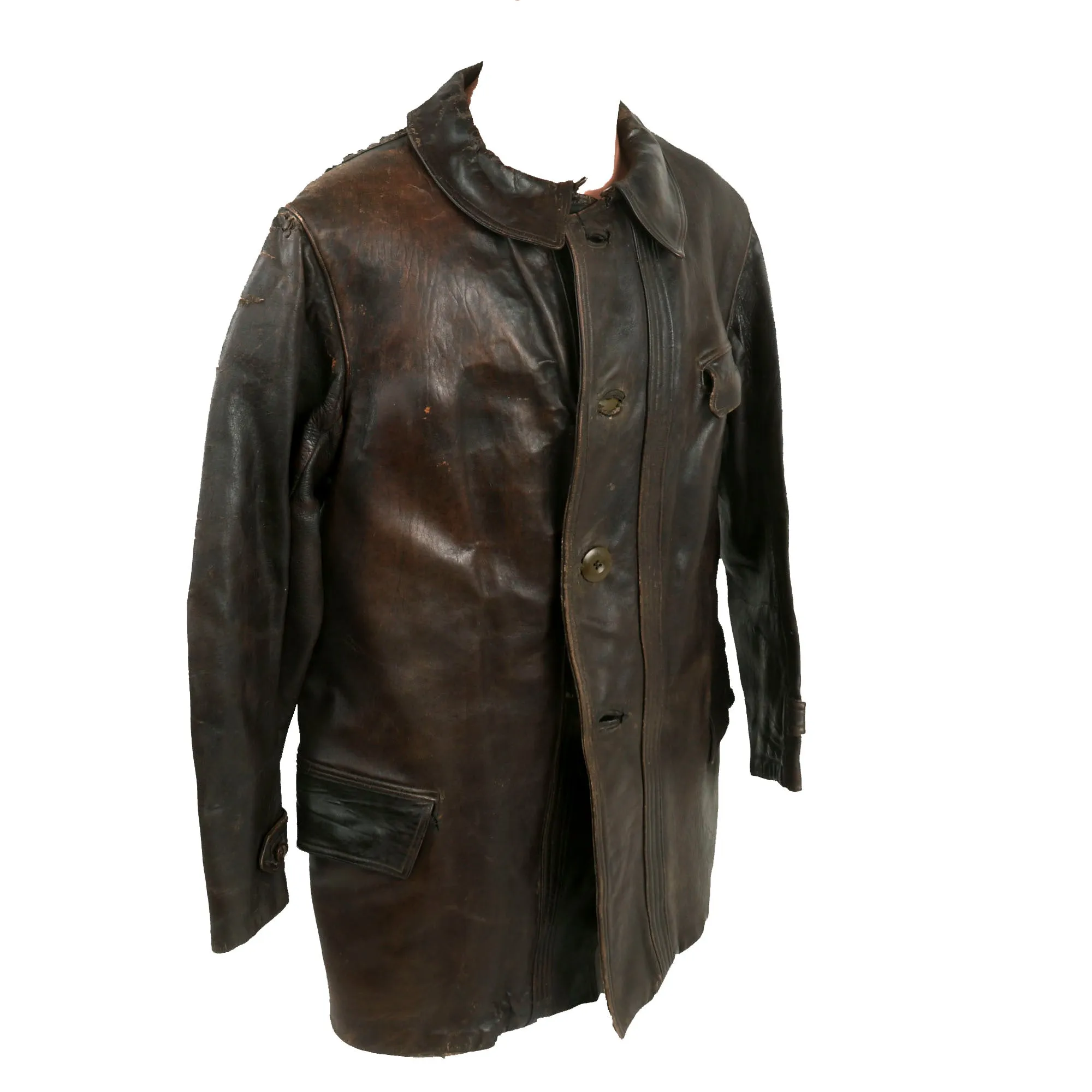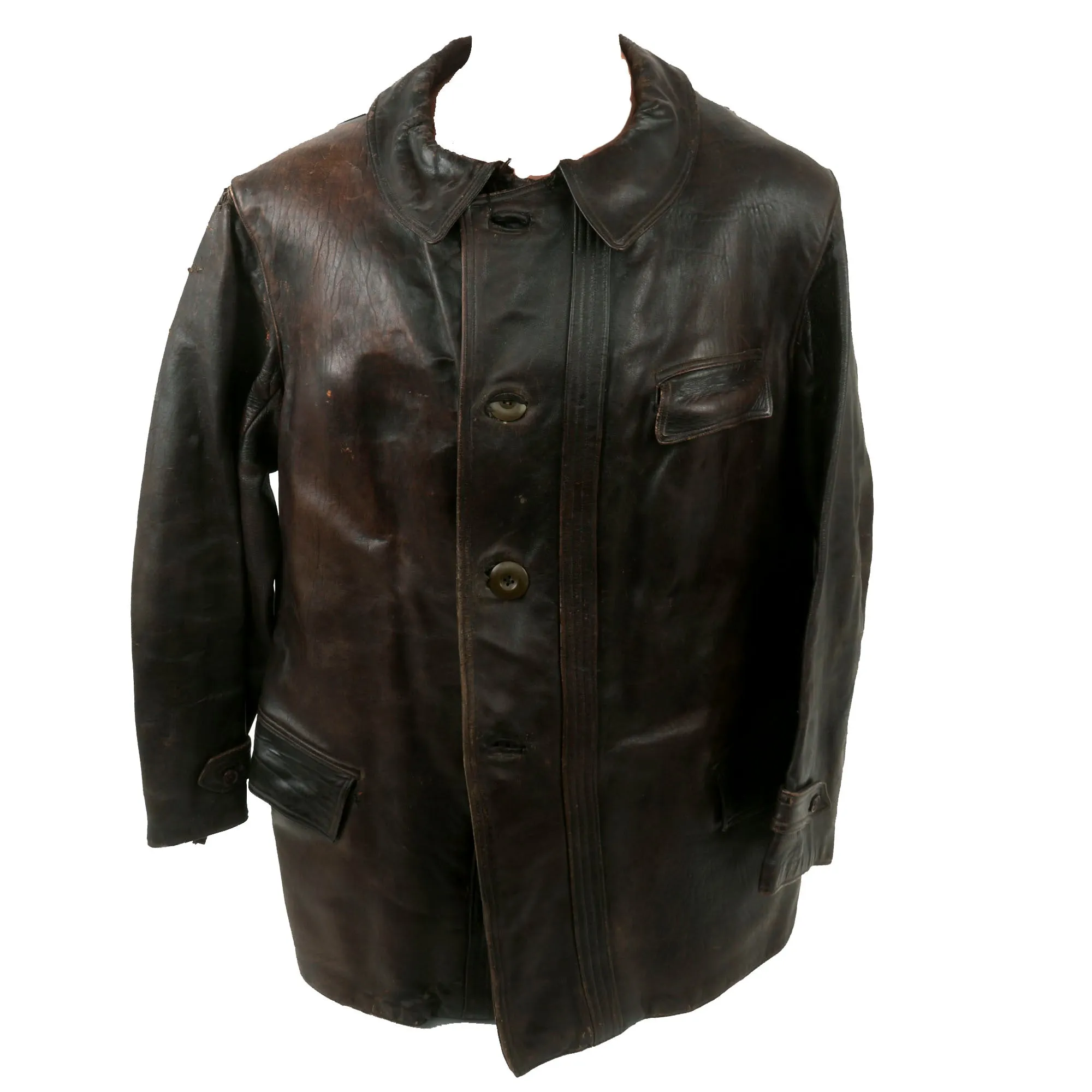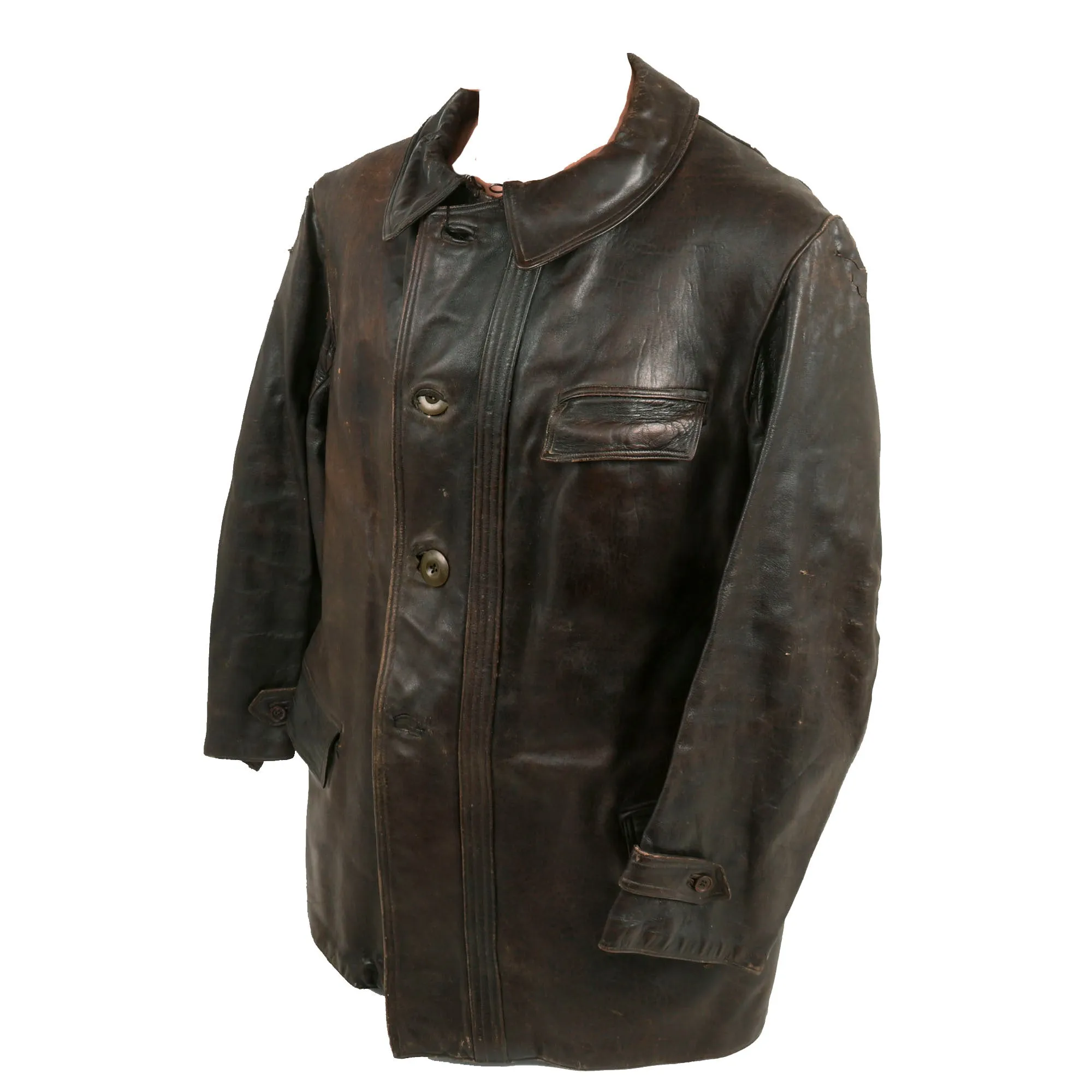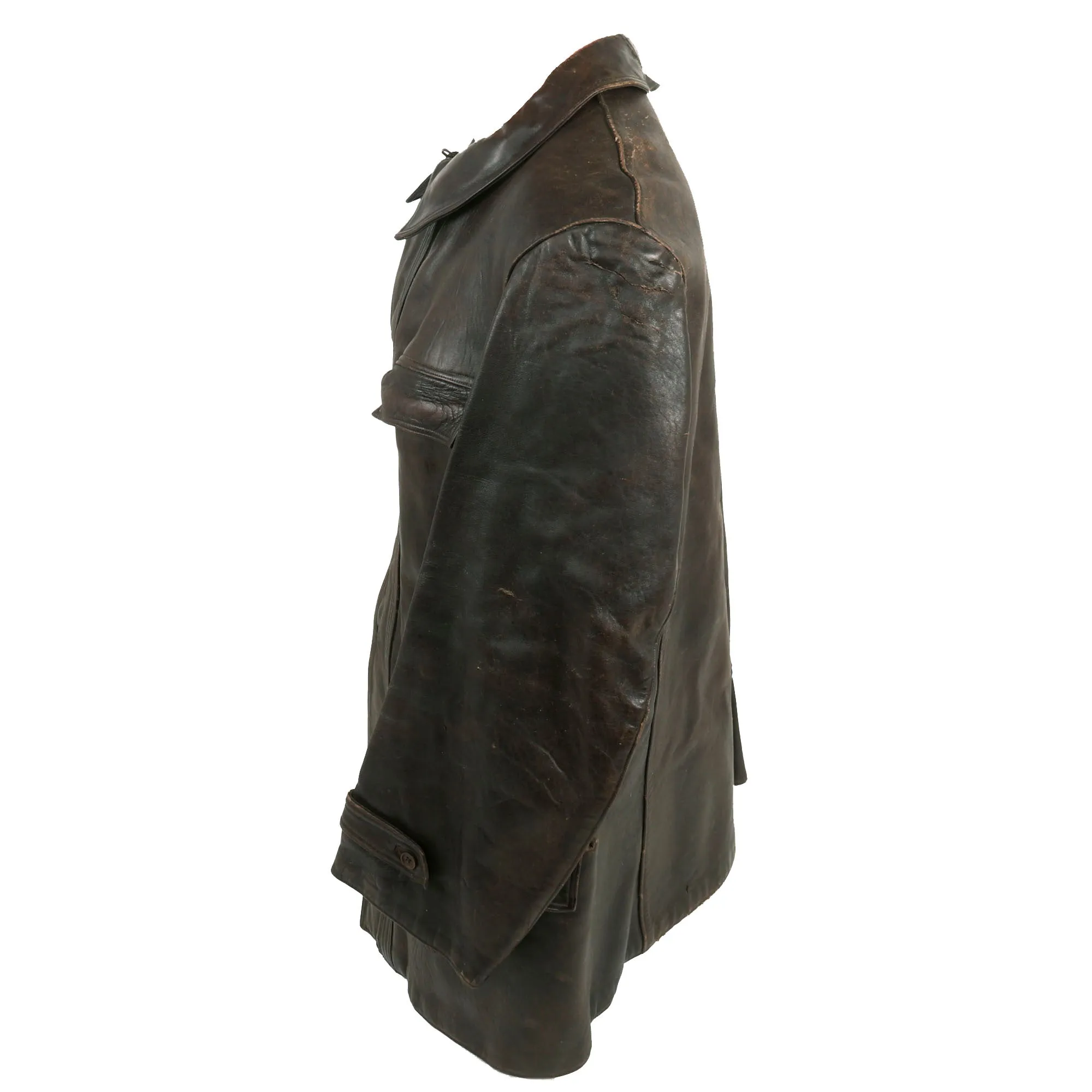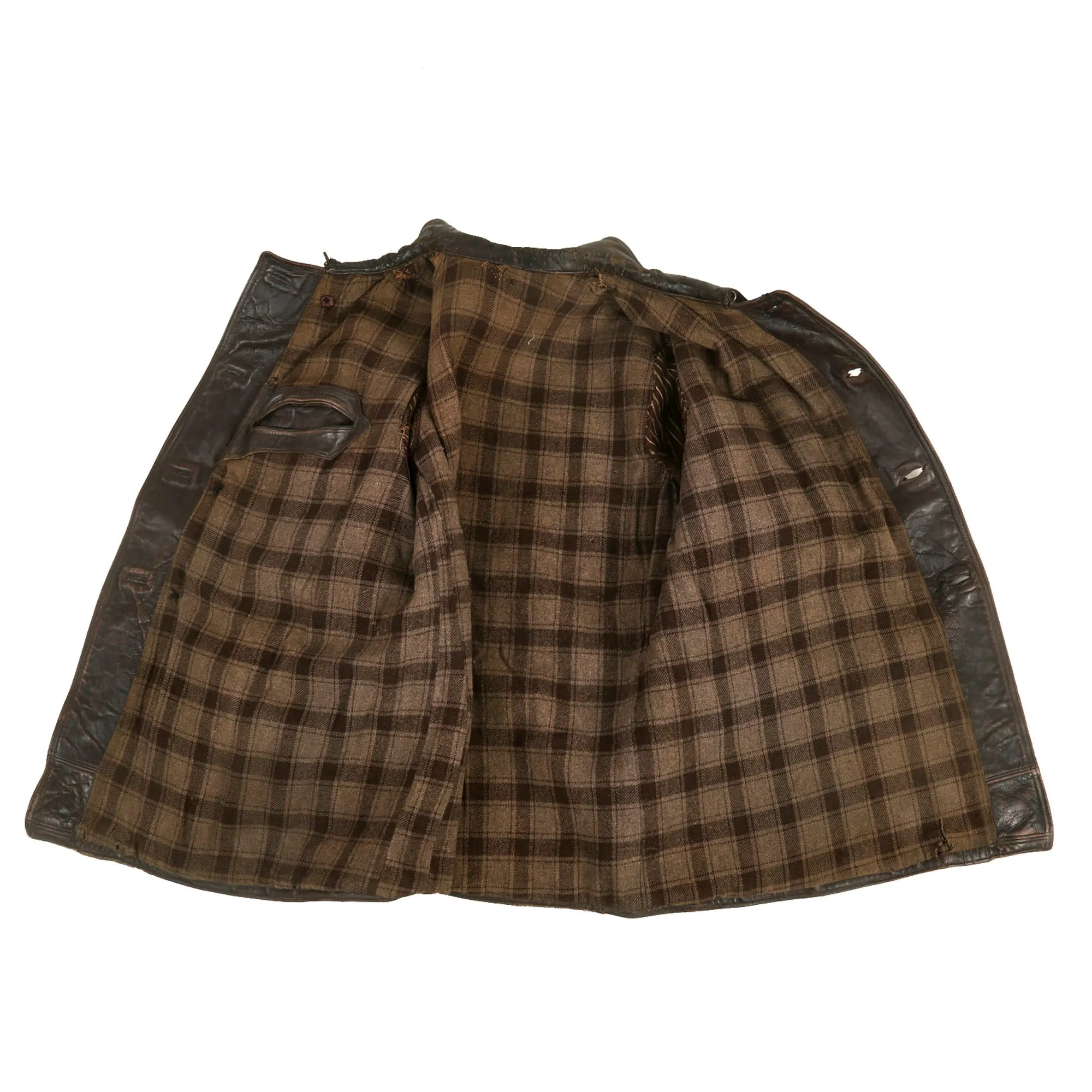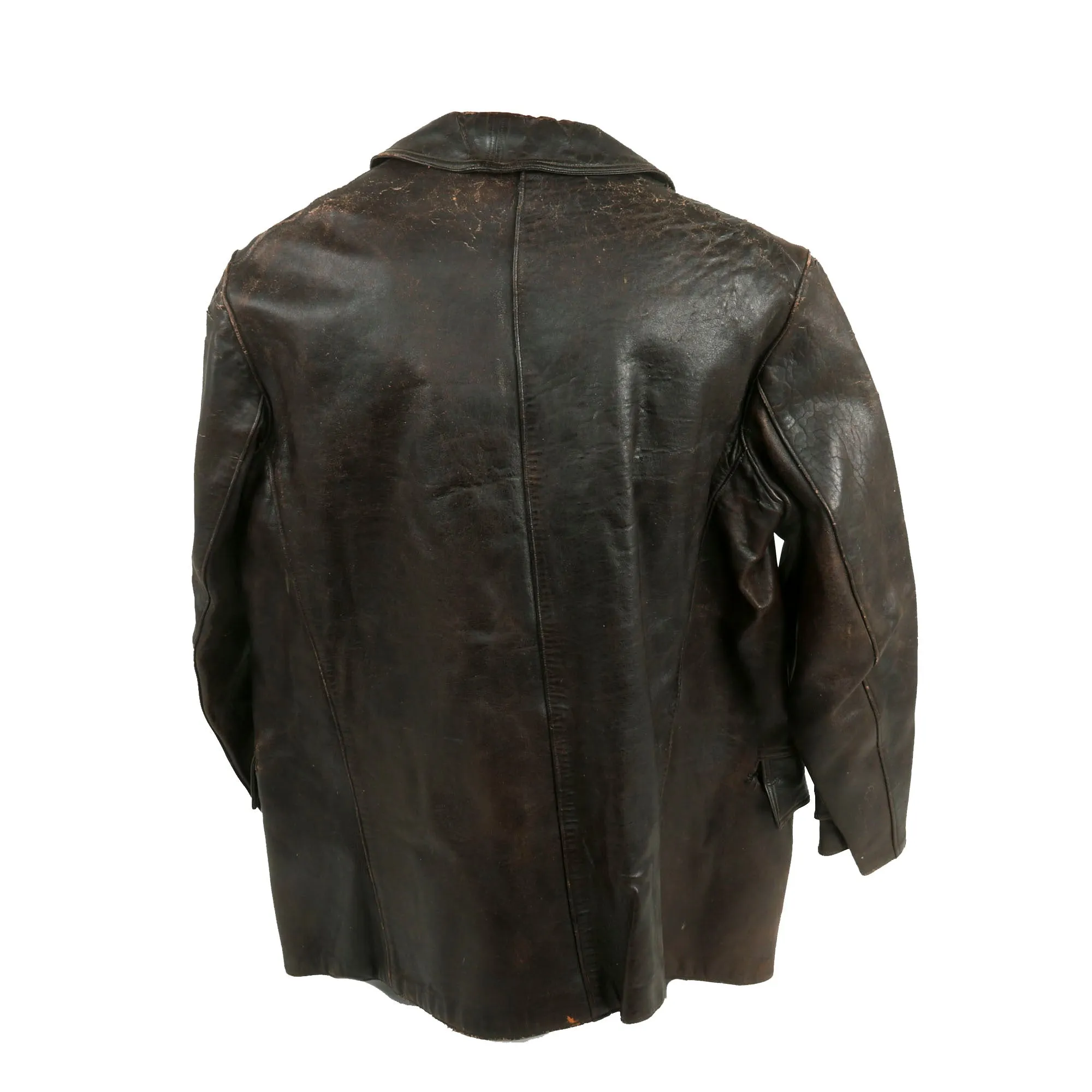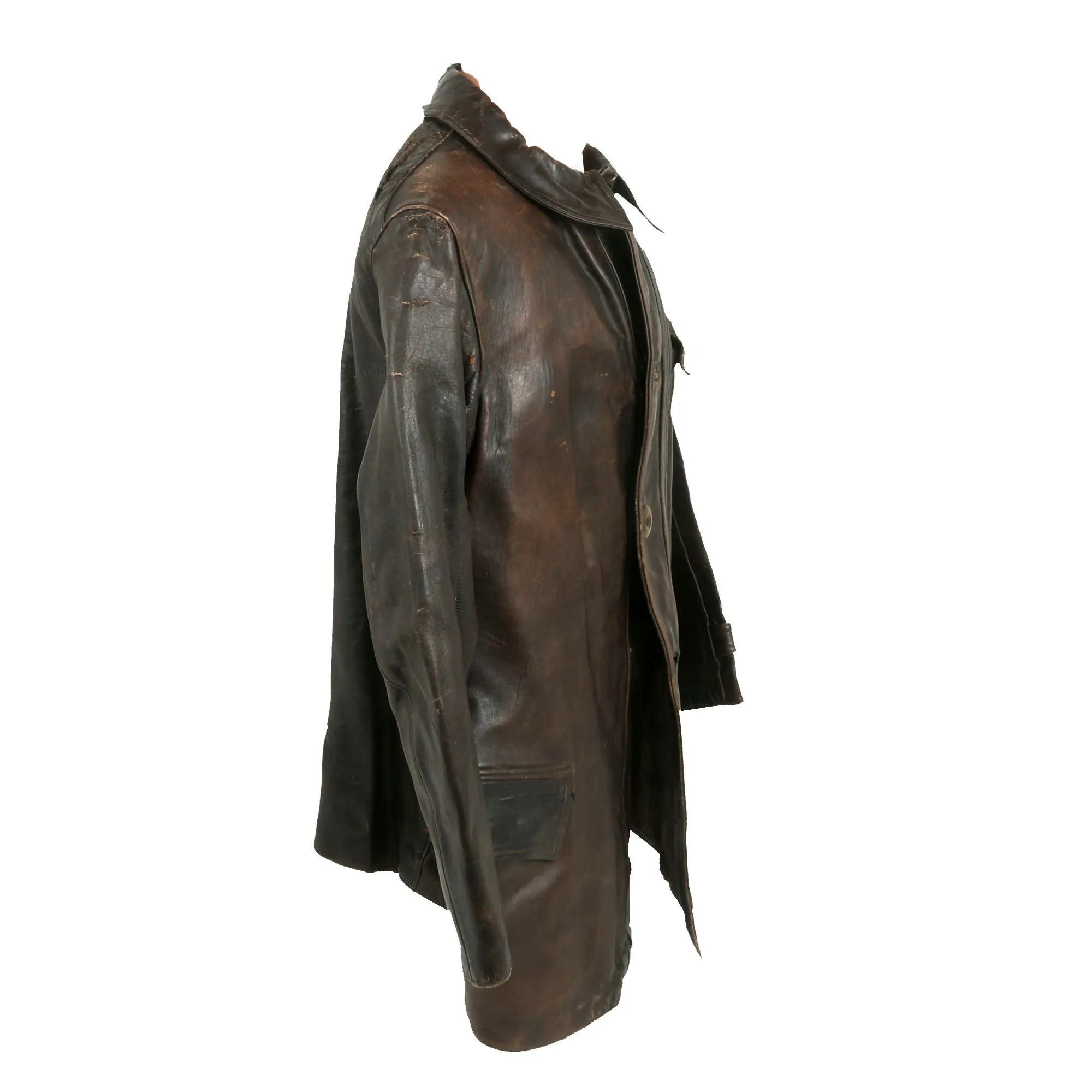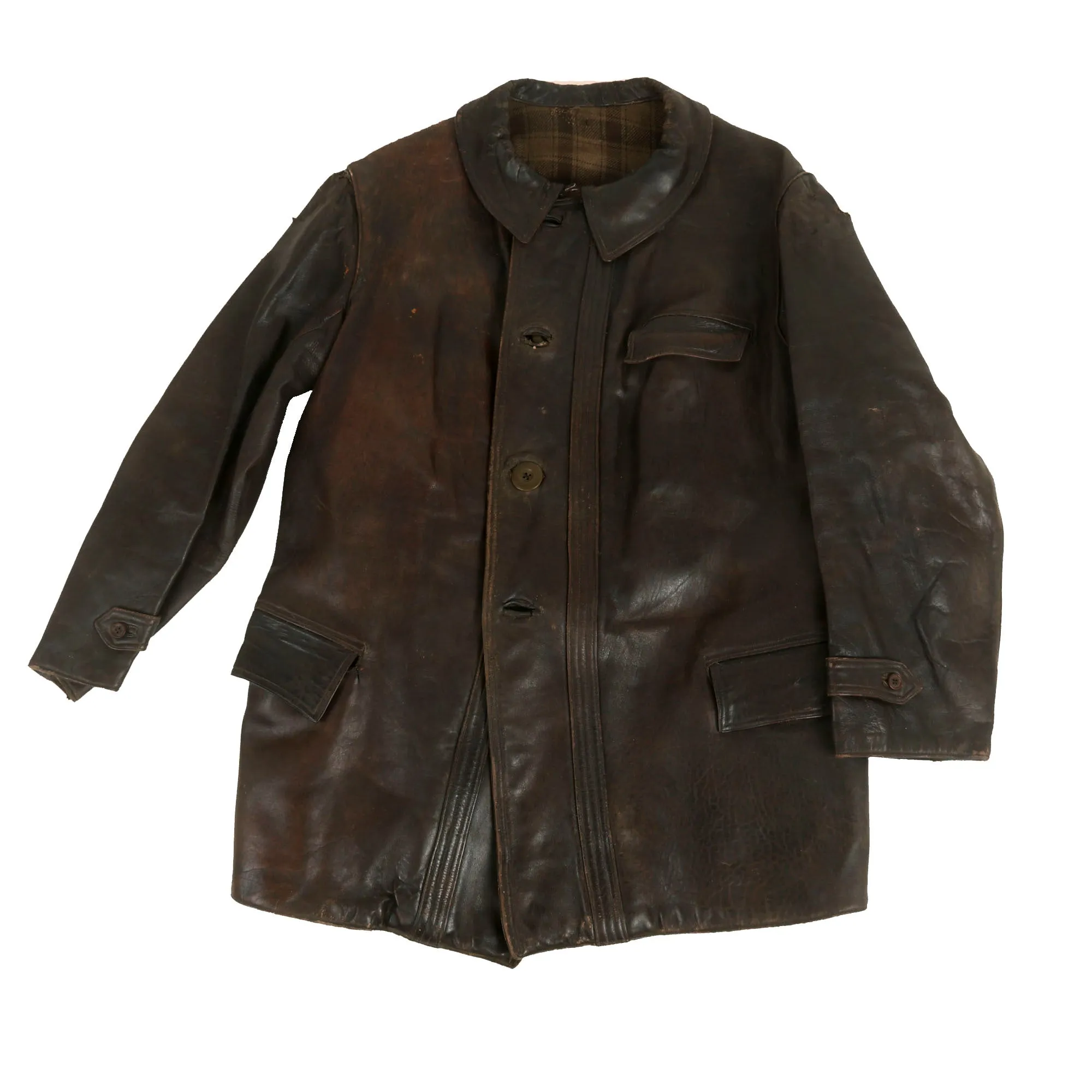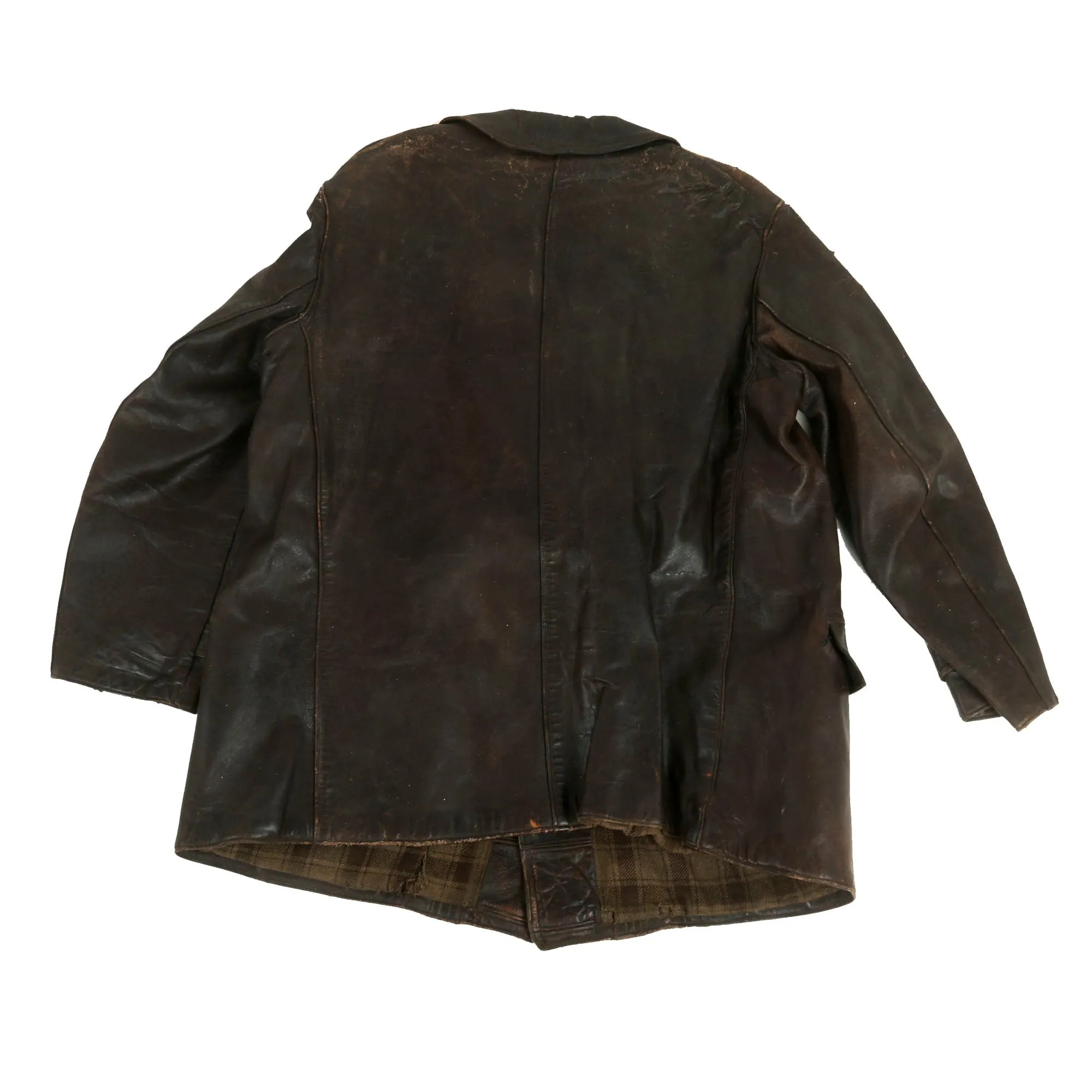Original Item: Only One Available. Imperial German Aviator’s Mid Length Leather Greatcoat with fixed flannel liner. An iconic piece associated with the flyers of WWI. This particular jacket is made of heavy brown leather lined with a lovely flannel in multiple shades of brown. The coat is in very good condition, especially considering its age. There are a few areas of loose stitching, such as under the right armpit. It is missing its original waist belt.
A great example ready for further research and display.
Approximate Measurements:
Collar to shoulder: 11.5"
Shoulder to sleeve: 25”
Shoulder to shoulder: 17”
Chest width: 22.5"
Waist width: 23.5"
Hip width: 25"
Front length: 33.5"
The Deutsche Luftstreitkräfte (German: German Air Force)—known before October 1916 as Die Fliegertruppen des deutschen Kaiserreiches (Imperial German Flying Corps) abbreviated to Die Fliegertruppe—was the air arm of the Imperial German Army. In English-language sources it is usually referred to as the Imperial German Air Service, although that is not a literal translation of either name. German naval aviators of the Marine-Fliegerabteilung were an integral part of the Imperial German Navy (Kaiserliche Marine). Both military branches operated aeroplanes, observation balloons and airships.
The Imperial German Army created an experimental balloon company inspired by the American balloon corps they had seen while observing the American Civil War, with varying forms of organisation from 1884 to 1901 until a Balloon Battalion was finally formed. The rapid development of aeronautics led to trials of airships and the choice of rigid types built by Zeppelin and Schutte-Lanz. The first military aircraft to be acquired by the German Army entered service in 1910 and the first five aviation battalions were established on 1 October 1913. The Imperial German Air Service (Die Fliegertruppen des deutschen Kaiserreiches) and other branches concerned with air matters such as anti-aircraft, home defence and air intelligence were unified in the Luftstreitkräfte on 8 October 1916.
The duties of such aircraft were initially intended to be reconnaissance and artillery spotting in support of the armies, just as balloons had been used during the Franco-Prussian War (1870–1871) and as far back as the Battle of Fleurus (1794) during the French Revolutionary Wars. The French Aviation Militaire (army air service) was created in 1910 and became the Aéronautique Militaire in 1912. The Air Battalion of the Royal Engineers, with two companies, was established in November 1911. The Royal Flying Corps, RFC with a military wing and a naval wing was formed in February 1912.
The initial units of the Luftstreitkräfte, dedicated to observation, were known as Feldflieger Abteilungen (Field Flier Detachments) and had an official establishment of six unarmed, two-seat "A" (monoplane), and/or "B"-class (biplane) aircraft apiece. Each "FFA" unit assigned to an army unit in their local area, and usually numbered with the same number as the army they were assigned to serve.The Luftstreitkräfte organization changed substantially as the war progressed, to accommodate new types of aircraft, doctrine, tactics and the needs of the ground troops, in particularly the artillery. During this time the system of organisation and unit designations evolved that would form the basis of those used in the Luftwaffe of Germany, when it was revealed in 1935. During 1916, the German High Command (Oberste Heeresleitung, OHL) reorganised Die Fliegertruppen by creating specialist fighter, bomber and reconnaissance units such as single-seat fighter squadrons (Jagdstaffeln, Jastas, hunting squadrons) to counter the Royal Flying Corps and the French Aviation Militaire.
The initial deployment of fighter aircraft in the summer of 1915 occurred within the Feldflieger Abteilung, which were being equipped with one or two of the new Fokker Eindecker fighter aircraft for each unit, starting with the five Fokker M.5K/MG production prototypes of the Eindecker, bearing serial numbers E.1/15 through E.5/15. The buildup of the Eindecker fighter force rapidly progressed with regular lMG 08 "Spandau"-armed production examples of the Fokker E.I following the deliveries of the M.5K/MG airframes late in the summer of 1915, with early E.Is going to aces like Max Immelmann, who received IdFlieg serial number E.13/15 in August 1915.
The first step towards specialist fighter-only aviation units within the German military was the establishment of Kampfeinsitzer Kommando (single-seat battle unit, abbreviated as KEK) formations by Inspektor-Major Friedrich Stempel in February 1916. These were based around Eindeckers and other new fighter designs emerging, like the Pfalz E-series monoplanes, that were being detached from their former FFA units during the winter of 1915–1916 and brought together in pairs and quartets at particularly strategic locations, as KEK units were formed at Vaux, Avillers, Jametz, Cunel and other strategic locations along the Western Front, to act as Luftwachtdienst (aerial guard force) units, consisting only of fighters.
Following the era of the KEK units through the summer of 1916, Jagdstaffeln (hunting squadrons), established by the reorganization that started by the late summer of 1916 were fielded by four kingdoms of the German Empire. Individually - each of these units was often known by the abbreviation "Jasta". The Kingdom of Prussia was predominant, with a fighter force eventually comprising 67 squadrons. The Kingdom of Bavaria formed ten of these units, the Kingdom of Saxony formed seven and the Kingdom of Württemberg four.
On 24 June 1917, the Luftstreitkräfte brought a quartet of Jasta squadrons together to form its first fighter wing, Royal Prussian Jagdgeschwader I, incorporating Jastas 4, 6, 10 and 11, and set the pattern for using Roman numerals in the Luftstreitkräfte in the titles of such larger units. Manfred von Richthofen was moved up from command of Jasta 11 to command JG I. Much as Jasta 2 had been renamed as Jasta Boelcke in December 1916 after Oswald Boelcke, Germany's top fighter tactician had been lost in a mid-air collision in October 1916, following the "Red Baron's" death in action in late April 1918, JG I was renamed to honor von Richthofen by order of the Kaiser.
The Prussians established three more Jagdgeschwader. On 2 February 1918, JG II formed from Jastas 12, 13, 15 and 19, with Adolf Ritter von Tutschek in command. On the same day, JG III consolidated Jasta 2 Boelcke and Jastas 26, 27 and 36 under Bruno Loerzer. Finally, on 2 September 1918, the Royal Prussian Marine Jagdgeschwader was formed from the Kaiserliche Marine's Marine Feld Jastas I through V and placed in charge of Gotthard Sachsenberg. Bavaria established the Royal Bavarian Jagdgeschwader IV on 3 October 1918, from Jastas 23, 32, 34 and 35 under Eduard Ritter von Schleich.
Between January and September 1918 German pilots shot down 3,732 Allied planes while losing 1,099 aircraft. By the end of the war, the German Army Air Service possessed a total of 2,709 frontline aircraft, 56 airships, 186 balloon detachments and about 4,500 flying personnel. After the war ended in German defeat, the service was dissolved completely on 8 May 1920 under the conditions of the Treaty of Versailles, which demanded that its aeroplanes be completely destroyed.




